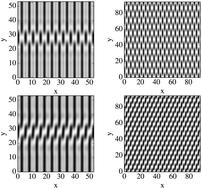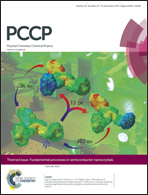Fronts and patterns in a spatially forced CDIMA reaction
Abstract
We use the CDIMA chemical reaction and the Lengyel–Epstein model of this reaction to study resonant responses of a pattern-forming system to time-independent spatial periodic forcing. We focus on the 2 : 1 resonance, where the wavenumber of a one-dimensional periodic forcing is about twice the wavenumber of the natural stripe pattern that the unforced system tends to form. Within this resonance, we study transverse fronts that shift the phase of resonant stripe patterns by π. We identify phase fronts that shift the phase discontinuously, and pairs of phase fronts that shift the phase continuously, clockwise and anti-clockwise. We further identify a front bifurcation that destabilizes the discontinuous front and leads to a pair of continuous fronts. This bifurcation is the spatial counterpart of the nonequilibrium Ising–Bloch (NIB) bifurcation in temporally forced oscillatory systems. The spatial NIB bifurcation that we find occurs as the forcing strength is increased, unlike earlier studies of the NIB bifurcation. Furthermore, the bifurcation is subcritical, implying a range of forcing strength where both discontinuous Ising fronts and continuous Bloch fronts are stable. Finally, we find that both Ising fronts and Bloch fronts can form discrete families of bound pairs, and we relate arrays of these front pairs to extended rectangular and oblique patterns.


 Please wait while we load your content...
Please wait while we load your content...